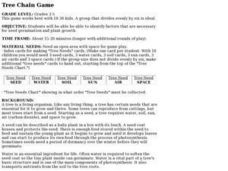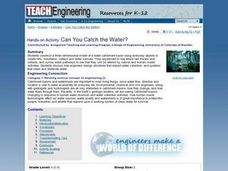Curated OER
Surviving on the Siberian Tundra
Students describe ways Nenets have adapted to their environment after listening to a National Geographic article about them. They compare their own adaptions to their environment with those made by the Nenet culture.
Curated OER
Soild Waste and Recycling
In this unit of lessons, students examine solid waste and recycling. They discover the concept of decomposition. They also observe the decomposition process and make observatins.
Curated OER
Don't Marry the Mole!
Third graders examine the power of solar energy. In groups, they create their own pizza box solar oven to discover the power of the sun and how it is a source for heat and light. To end the lesson, they use the internet to examine...
Curated OER
Aquatic Communities
Learners watch a video about aquatic communities. They conduct an experiment that shows how movement of rivers change the landscape. They compare fresh and salt water communities and its wildlife.
Curated OER
Grain Properties Activity
Students study the similarities and differences of five different grains. They analyze the characteristics of corn, sunflower, milo, wheat, and soybeans.
Curated OER
Birds of A Feather
Young scholars observe and record the many types of birds they see in a month. They discover the many patterns birds follow and compare their results with other classrooms. They complete a field assessment as the final activity for this...
Curated OER
Keep in Touch: Communications and Satellites
Young scholars investigate how satellites help people communicate with others far away and in remote areas. They discuss a scenario of someone travelling to an area with no mode of communication, observe a teacher demonstration, and...
Curated OER
Planting A Garden On Campus
Students investigate the school campus area in order to plan the best spot for a class garden. They create a map of the school and research the different types of soil that exist in order to find the best spot. The class takes the...
Curated OER
Wild Lion Vets
Pupils research and explore the "king of the beasts" then make their own field guide of cats by doing research on each one and including information such as appearance, habitat, range, and food.
Curated OER
A River Ran Wild
Students describe and illustrate pollution and how to clean up pollution. They display their solutions by creating posters, signs, bumper stickers, slogans, T-shirt designs, commercials and poetry. This lesson ties in with 'A River Ran...
Curated OER
Tree Chain Game
Learners identify the necessary factors for seed germination and plant growth in a game format.
Curated OER
Compost Tag
Students identify biodegradable items. In this environmental lesson, students participate in a game of tag. A student's name is called out along with a biodegradable item and the student is tossed a ball.
Curated OER
Adopt An Animal
Students view slides of pictures of rare animals and make predictions about them based on the characteristics they see. In this animals lesson plan, students then research one of the animals and present their findings to the class.
Curated OER
NATIVE AMERICANS
Students study the importance of nature to Native Americans and discover the growth stages of Northern beans and mustard seeds.
Curated OER
Naming the Body Parts
Students study about butterfly and catepillar parts. Throughout the week, they use various notecards, overhead transperancies, books, and matching games to study about the part names. They are given a test to fill in blanks with the...
Curated OER
How Does Climate Affect Your Environment?
Students access the Global Sun Temperature Project website and research the relationship between the location and climate of a participating school to its building structure. They consider how climate affects the type of structures...
Curated OER
The Heat is On
Third graders experiment with heat through investigations. They rub objects together and compare the relative differences in the amount of heat given off. They write in their journals about the results they find.
Curated OER
Can You Catch the Water?
Pupils work together to construct a model of a water catchment basin. They survey water patterns and complete experiments to see where rain travels and collects. They discover how engineers design structures that help with drainage.
Curated OER
Bat Facts
Student's demonstrate an understanding of basic facts about bats by creating a picture representation of bats in their habitat describing information they learned. The lesson is especially favorable for visual learners.
Curated OER
Exploring Bats
Third graders create a graphic organizer about bats in cooperative groups. The graphic organizer is used to illustrate the information that has been researched. The specific graphic organizer is the KWL.
Curated OER
Cells
Students learn about cells. In this cells lesson plan, students take several days to learn about plant and animal cells and make their own edible cells with a cookie and icing.
Curated OER
Habitats and Functions
Students analyze and discuss insect diversity and all of the functions that insects perform in nature. They examine habitat and function cards, and distribute themselves by function and habitat.
Curated OER
Cockroaches
Students listen to a lecture on cockroaches. They work in pairs to design a cockroach trap and attempt to trap a specimen. They complete various other cockroach-related activities.
Curated OER
Land Use in New Hampshire: Farming
Students examine how the environment as affected people farming in New Hampshire. They visit a field trip to a local farm to make observations. They create a poem based on their observations.























